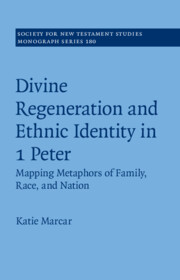Book contents
- Divine Regeneration and Ethnic Identity in 1 Peter
- Society for New Testament Studies
- Divine Regeneration and Ethnic Identity in 1 Peter
- Copyright page
- Dedication
- Contents
- Figures
- Tables
- Acknowledgments
- Note on the Text
- Abbreviations
- Introduction
- 1 Ethnicity Ancient and Modern
- 2 A Field Guide to Metaphors
- 3 The Structure of 1 Peter
- 4 Begotten Anew
- 5 Seed Metaphors in Jewish and Early Christian Literature
- 6 Newborn Babies and Spiritual Milk in 1 Peter 2:1–3
- 7 From House to House of God
- 8 From (Re)Generation to Ethnos
- 9 Conclusion
- Appendix The Language of Rebirth in Rabbinic Judaism
- Bibliography
- Subject Index
- Ancient Sources Index
1 - Ethnicity Ancient and Modern
Published online by Cambridge University Press: 01 June 2022
- Divine Regeneration and Ethnic Identity in 1 Peter
- Society for New Testament Studies
- Divine Regeneration and Ethnic Identity in 1 Peter
- Copyright page
- Dedication
- Contents
- Figures
- Tables
- Acknowledgments
- Note on the Text
- Abbreviations
- Introduction
- 1 Ethnicity Ancient and Modern
- 2 A Field Guide to Metaphors
- 3 The Structure of 1 Peter
- 4 Begotten Anew
- 5 Seed Metaphors in Jewish and Early Christian Literature
- 6 Newborn Babies and Spiritual Milk in 1 Peter 2:1–3
- 7 From House to House of God
- 8 From (Re)Generation to Ethnos
- 9 Conclusion
- Appendix The Language of Rebirth in Rabbinic Judaism
- Bibliography
- Subject Index
- Ancient Sources Index
Summary
This chapter examines modern and ancient conceptions of ethnicity. For Smith, six elements constitute ethnicity: a name, myth of collective descent, history, culture, territory, and a sense of solidary. However, a connection with a special territory and the myth of common descent are particularly important. David Horrell has demonstrated that these six elements are active in 1 Peter. Ethnicities are expressed in culturally specific ways. Therefore, this chapter examines conceptions of ancient Jewish and Greek ethnicity, with particular focus on putative common descent. Most Jews in the Second Temple period were Jewish by birth. However, the possibility of conversion and apostasy complicate the picture. Along with birth, Jewish identity was maintained through social praxis. In the Hellenistic period, “Greekness” came to be identified with paidaeia, or education. Those not born Greek could become Greek. Yet, “Greekness” never fully lost its connection to birth. In both Jewish and Greek culture, birth and paidaeia continued to constitute ethnic identity in a complex tension.
Keywords
- Type
- Chapter
- Information
- Divine Regeneration and Ethnic Identity in 1 PeterMapping Metaphors of Family, Race, and Nation, pp. 7 - 23Publisher: Cambridge University PressPrint publication year: 2022

